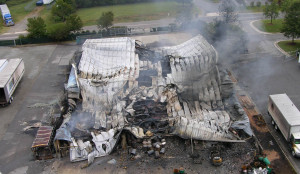A fire and several explosions occurred in a special industrial waste (SIW) treatment plant. Bothered by smells, residents alerted the emergency services at around 9.30 pm describing a possible chlorine leak. The emergency services rushed to the scene to locate the source of the gas cloud emitted, and determined that the atmospheric releases had resulted from an outbreak of fire in the SIW treatment plant. This fire had spread to the 200 L drums of flammable solvents and paints, several of which exploded forming 30 m high fireballs. In a few minutes, the entire building, that had a metal structure and was open on two sides, was on fire and releasing a significant amount of smoke.
An emergency situation was declared, a significant safety perimeter was set up and over 300 firefighters were mobilised. Due to the dangerous nature of the products stored (paints, solvents, pesticides, herbicides, etc.), people living downwind of the plant were evacuated, i.e. 17,000 people from a total population of 32,000. Schools and businesses located within the emergency response area remained closed for 24 hours. The people evacuated were only permitted to return to their homes 36 hours after the start of the disaster, the time needed to take pollution measurements on the water, air and soils and to rule out any health risk. Faced with concerned residents, new measurements (all negative) were nevertheless taken in the following few days, inside and outside of dwellings. The operator paid for these analyses ($ 150,000), and for the cost of the emergency services ($ 200,000) and evacuation operations. Over around one hundred people were hospitalised (< 24 h) affected by respiratory disorders, including 13 police officers who were first on the site and 106 residents of a nearby retirement home.
To avoid aggravating the environmental consequences of the accident and unnecessarily placing themselves in danger, the emergency services decided not to attack the fire directly and left it to burn; in places the flames were 45 m high, and explosions with fireballs (BLEVE) were observed. A 1st emergency response team entered the site the next day at the end of the morning. The storage building had collapsed and 3 fires continued to burn under the rubble. Several hours were needed to extinguish them due to problems in accessing the fires. Finally, the fire was extinguished a little after midnight.
An enquiry was carried out by the Chemical Safety Board (CSB) to determine the causes of the accident. It highlighted that the risks were significantly underestimated: building with no continuous monitoring, no fire detection system, fire protection equipment limited to a few extinguishers, inexistent emergency plan (no information for the emergency services on the type and amount of waste stored), etc. In addition, 6 storage areas, delimited by 1.8 m high and 90 cm wide borders, were used to contain a small leak and prevent possible mixing of incompatible products between the areas, but not to prevent the spread of a fire.
As the fire broke out in the oxidising products storage area, the cause of the fire was the mixing of incompatible chemicals that had led to an uncontrolled reaction with the production of flammable gases. The startup of oxygen generators accelerated the fire’s development, which then spread to the flammable waste area.
The Chemical Safety Board (CSB) issued recommendations concerning SIW centres (fire protection, information for authorities and neighbouring populations, etc.). Faced with hostility from the population, reconstruction of the plant was uncertain.




